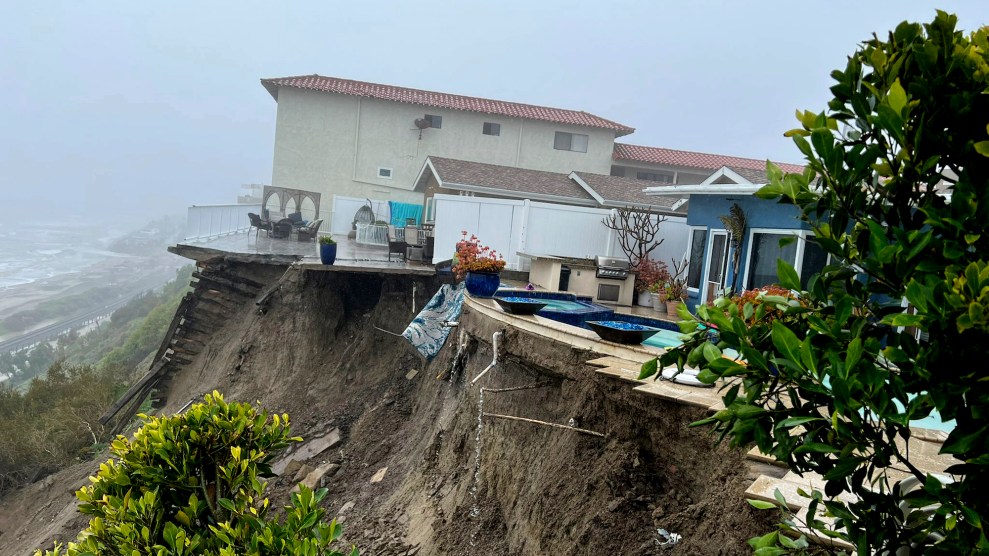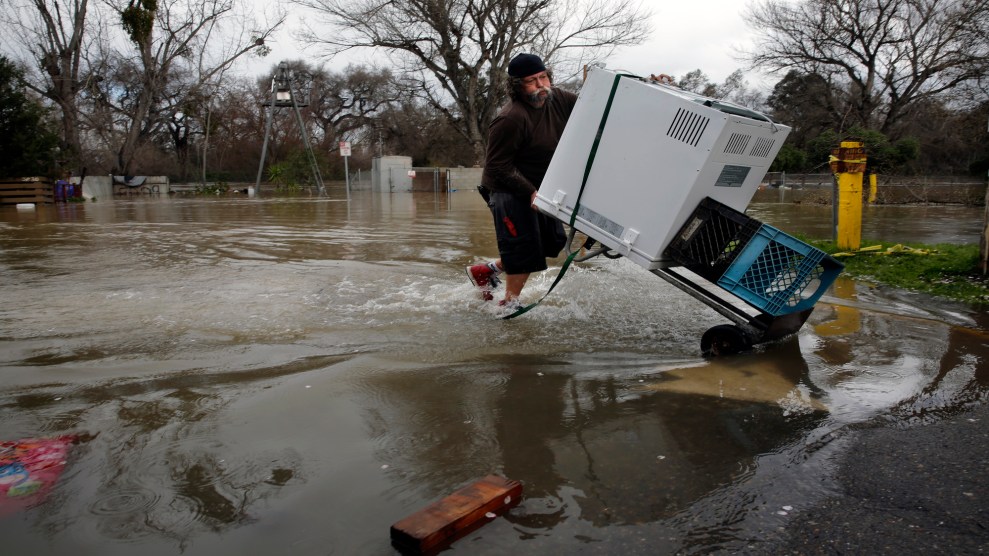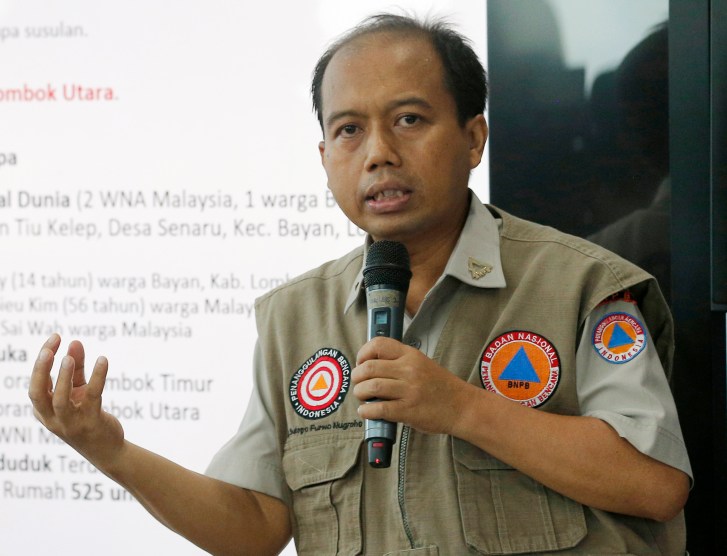
A home in San Clemente, California that was evacuated due to a landslide in March 2023.Orange County Fire Authority/AP
This story was originally published by Inside Climate News and is reproduced here as part of the Climate Desk collaboration.
A global increase of extreme precipitation, well outside the range of natural variability, has been well-documented by scientists. It’s one of the hallmarks of human-caused global warming, and new research published this week in Nature shows that high-elevation areas, including most of the mountains of Western North America, are particularly vulnerable to deluges that can trigger landslides, floods and severe erosion.
The research by the Department of Energy’s Lawrence Berkeley National Laboratory focused on rainfall extremes, “owing to their instantaneous triggering of runoff and association with floods, landslides and soil erosion,” the authors wrote. Previous research into extreme precipitation events, however, had not focused on whether the deluges fell as rain or snow, and how that affected downstream impacts.
“We’ve known for decades that as the atmosphere warms, it can hold more water vapor and that water will eventually come back to land as precipitation,” said first author Mohammed Ombadi, who has a background in civil engineering and did the modeling study as a postdoctoral researcher at the Berkeley Lab. “Our estimate of that was, it’s going to be about 7 percent with each degree (Celsius) of warming.”
But the researchers found that the increase in rainfall as the warming atmosphere grows more saturated was far greater than they expected. “What our work is showing is that if you only single out the liquid part, and look at rainfall extremes separately, that rate is almost more than doubled to 15 percent,” he said.
Their research also suggested a linear rate of increasing extreme rainfall with future warming. The most current estimates put the world on a path to heat by up to 3 degrees Celsius by 2100, which would bring a 45 percent increase of extreme rainfall over many mountain areas.
“A big message here is that every degree matters, because it comes with this additional increase,” he said. “We see this amplified increase in rainfall extremes over most high elevation regions and mountains of snow-dominated regions across the northern hemisphere. And we see that mountain ranges in Western North America are at greater risk than other mountain ranges.”
The new research didn’t pinpoint the exact reason for the higher risk of extreme rainfall in those mountains, but Ombadi said the researchers suspect it’s because most precipitation extremes in those regions happen during winter snowstorms at temperatures just below freezing.
This past winter’s extreme snowfall in California’s Sierra Nevada Mountains showed the growing threat clearly when streams and rivers flowing west from the mountains into the Central Valley swelled and refilled Tulare Lake, north of Sacramento. Weather and climate experts were on pins and needles for several weeks in mid-winter, warning that a warm and rainy storm could set off catastrophic flooding.
A worrying aspect of the new study is that it supports a growing body of scientific evidence that rainfall extremes may outpace projections, said Hayley Fowler, a climate extremes researcher who was not an author of the new paper.
She said that, until recently, “there was thought that intensification of extreme rainfall was really quite constrained” by the well-known relationship between the temperature of the atmosphere and how much moisture it can hold. Scientists call it the Clausius–Clapeyron relation, which shows the water-holding capacity of the atmosphere increasing 7 percent per 1 degree Celsius of warming.
“It’s pointing to the fact that we are going to, potentially, see much bigger changes than we think in extreme rainfall,” she said. Some of her own research on short-duration rainfall extremes suggests local conditions can drive increases beyond 7 percent, for example when rising air over extremely hot land areas pulls in more moisture and from surrounding areas.
“You get more moisture convergence from these local processes and so you can get much bigger increases,” she said. “But then you also get the change from snow to rain. So it’s kind of bringing together compounding factors that together can have a much bigger effect than we thought.
“When we look at the average over a large region, what we tend to see is an increase approximating the 7 percent of Clausius–Clapeyron relation,” she said. “But then what can happen, and what seems to happen more and more with climate change, you get these increases concentrated into smaller areas. That means that the impact in smaller areas is much bigger than then you’re potentially planning for. But you don’t know where these events are going to fall.”
It’s not always possible to predict what related impacts the intensifying rains will trigger, but the threats are many, ranging from glacier collapses and glacial lake outburst floods to giant wet snow avalanches, rockfall, mudslides and massive erosion in fire-scarred areas.
Ombadi said more intense rainfall can exacerbate all those things, which suggests that global warming isn’t just intensifying the Earth’s water cycle, but may also be accelerating parts of the geological cycle, crumbling more rock faster and moving more sediment and debris through rivers and lakes and into the oceans. Another hypothesis, he said, is that more heating evaporates soil moisture, which intensifies rainfall even further.
“This tells us that we should be more aware and invest more in adaptation and mitigation strategies to really prepare the communities living in the Western U.S. for those kinds of rainfall extremes and the associated hazards of floods, landslides and so forth,” Ombadi said, noting that civil engineering may not be keeping pace with climate change. “We need to factor these results into how we design and build the infrastructure in these mountainous regions, so that they can withstand the negative consequences of increases in rainfall extremes.”
Engineers typically design infrastructure using estimates of extreme rainfall events from the past 50-70 years, he said, which doesn’t account for changes in the intensity of precipitation and rainfall extremes. New model studies like the one he led can help refine the range of potential threats to help civic planners prepare.
The risks aren’t limited to people living in the high mountains. About a quarter of the world’s population lives in areas directly downstream of mountains, and they all stand to be affected by the increase of extreme rain, including many people in developing countries who don’t yet have much access to climate data.
While some of the extreme rain hotspots are in developed areas, he said, a significant portion of the developing world, including regions downstream of mountains in countries like India, Pakistan, Nepal, and other Asian countries, will also be affected by these risks.
He said the new study was limited to looking at the Northern Hemisphere because of a lack of observational data from places in the Global South like the Andes.
“This is especially concerning because those countries often lack the resilience and resources to effectively mitigate these extreme events in the short term,” he said. “Therefore, it becomes crucial to prioritize long-term investments in resilient infrastructure in these regions.”












